

Educating divers not just teaching coursesIANTD, BSAC, SSI, PADI and SSI TXR Technical
This is a little over due and comes after a long discussion on the Sidemount Diving group page on Facebook. One of the members – Max, wanted to find an alternative to using regular cylinder lanyards. His initial idea is below, and while functional, can be improved I think, though several modifications.
note - DiveRite’s Ring Bungee system is designed for this exact requirement, but does add the need to use a standard stage strap and tank choker.
Maxs' Original Facebook Post – 14 March 14
I would like your opinion on this thread that I just posted on ScubaBoard. Its a bit long and FB doesn’t allow for much formatting so I’m linking to the thread instead of reposting the whole story here.
Basically, I’m try to find an alternative to using regular tank lanyards (or ring bungees) and I’ve got an idea on which I’d like to have your feedback. I’m posting some pics of it here and you can get the long-winded explanation on ScubaBoard.
All constructive comments welcomed!
Link to explanation: http://www.scubaboard.com/forums/sidemount-diving/478460-possible-alternative-way-doing-tank-lanyards.html#post7065206
I use a length of 550 parachute cord and tie it into a loop using a Double Fisherman’s bend.
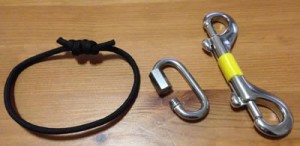
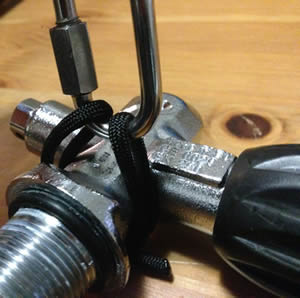
Clip ready for use

Parts required for Max's solution
I then wrap this loop around the tank’s neck and secure it with a small Quick Link (1.5 in | 3.8 cm). The length of the cord is adjusted so that the loop and Quick Link are sufficiently able to move around the neck of the valve but are not too long as to protrude more than a couple of inches when taught.
Para cord around valve
I then attach one end of a Medium Double-Eye Bolt Snap (4 in | 10 cm) to the Quick Link (see images below). The other end of the bolt snap will be clipped to the shoulder d-ring.
bolt snap on
The idea is to clip the tanks to the harness, route the hosing, prep for entry, then once in the water, unclip the bolt snaps completely and stow them somewhere. I like the butt d-ring but where you stow them is completely up to you. You then loop the bungees around the tanks and off you go. You can do this when you feel comfortable: right away on the surface before going down, immediately after submerging while hovering in place (S drill anyone?) or after you’ve descended to the bottom. Just do it when you feel secure enough that you are not task loading yourself such as during the descent (clearing your ears, working your BCD, holding the line, etc).
Coming back up, you do the reverse. Only this time using all the time you need during your 3 minute safety stop. While practicing, I could undo the bungee, fetch the clip, clip it to the Quick Link and then the shoulder d-ring in about 10-15 seconds for each tank (I’m sure you guys can best this time!).
A New (alternitive) way
An Alternative Method
After looking at what Max was trying to achieve this is the method I would use to improve on it. I does require that the cylinders are personal and not daily rented as it takes a bit to set up.
However my preferred method is is just to use the tight bungee method, which can be added daily, see pic below.

Parts
The following elements are required to complete the full permanent clip
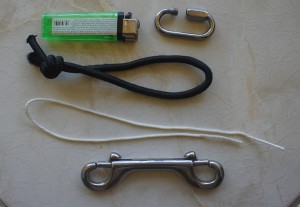
Method
Place one end of bungee loop on to quick link, leaving gap in quick link open.
Thread bungee around neck of cylinder, ensuring knot is centered under valve opening and link is on back of valve, thread other end of bungee over opening in quick link (difficult – use reel cord to pull around (you can stop here if not using your own cylinders, for easy removal) – see pic of completed link.
Taking your cave/reel line loop around the bungee (see pic – best if a friend can pull link using the bolt snap allowing you to work more easily)
If you know how to tie a bolt snap to a long hose – this is the same method.
Wrap around the bungee , crossing the line and preparing to tie a reef knot.
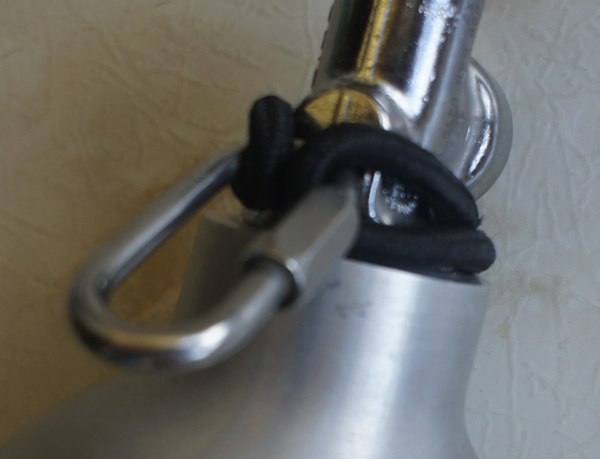


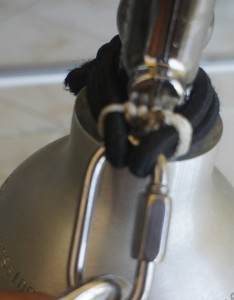

This is the final clip.
The quick link stands up, allowing easy clipping and unclipping of the bolt snap from the cylinder using only one hand. Once removed there is very little to get entangled and clip can be cut away if needed.
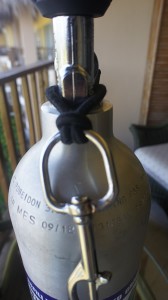
This is the regular ‘backup’ method I normally use. It differs from some as bungee is used not para-cord, the bungee is very short and the clip is only used for walking with the cylinder (Max’s issue) and if I get get a main bungee failure. I also use this for tec sidemount stage cylinders.
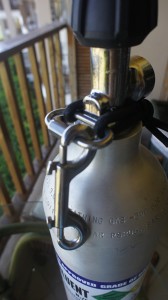
This the the easier and quicker method, recommended if not using your own cylinders and you want a minimal look in water.
It is easy to fit and remove. It is much improved over using the quick link with para cord, because the bungee keeps the quick link tight but stood up enabling easy clipping (bungee MUST be tight)

This is the same bungee method but now using a regular bolt snap. An example of use is when changing a normal sidemount cylinder setup to a tec sidemount cylinder. this creates the correct amount of stand-off when the cylinder is BELOW the main sidemount cylinder and top clipped to the shoulder d-ring